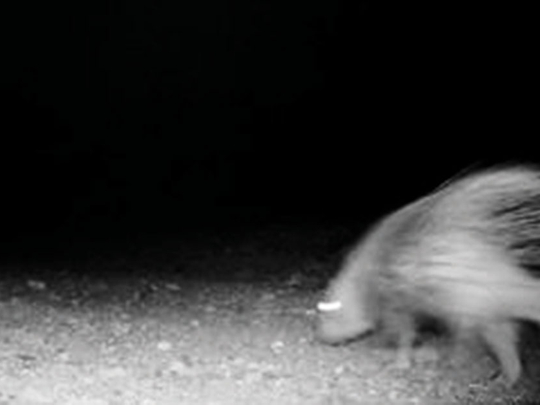
Fujairah: The first confirmed sighting of the Indian crested porcupine, the largest rodent in Arabia, was made in the UAE at the Wadi Wurayah National Park (WWNP), it was announced on Wednesday.
The Fujairah Municipality on Wednesday confirmed the first photographic evidence of the Indian porcupine (Hystrix indica) taken near farms on the eastern side of the Wadi Wurayah National Park. The porcupine was spotted approximately 600km beyond its known range in the central desert of Oman.
The first images of the nocturnal animal showed it being followed by an Arabian red fox. They were captured in October 2015 by a camera trap set by Fujairah Municipality team at the park as part of their wildlife monitoring and research programme. Additional images were captured in the same area a month later.
Engr Mohammad Saif Al Afkham, Director-General of Fujairah Municipality, said the discovery emphasised the importance of WWNP not just locally but also globally as one of the important wetland sites in the Arabian Peninsula and also the 2nd Unesco Biosphere Reserve of the UAE, as announced in July this year.
Al Afkham lauded the Fujairah municipality team’s efforts in achieving this important scientific discovery, which brings the total number of recorded native and naturalised rodent species in the UAE from 10 to 11.
Dr Ali Hassan Al Hmmoudi, park manager at WWNP, said though the first images were taken three years ago, the team had to conduct an extensive two-year research to confirm the finding and have it published in the scientific Journal of Threatened Taxa in June 2018.
“The population of the species is not known yet because this is the first confirmed record and sighting. We think there may be two Indian porcupines at the park as of now,” Dr Al Hmmoudi told Gulf News.
“This finding is very significant because the Indian porcupine is not known to inhabit this area. The main population is found outside the UAE, in Oman and Saudi Arabia. It also significant in terms of the addition of species of this size in the country’s wildlife record. Knowing that we have this kind of species, we can protect it for future generations,” he said.
Considering its extremely small number in the UAE, the Indian porcupine may meet the criteria for ‘critically endangered’ classification at a country level. More research is needed and a re-introduction programme of the species may be needed to support the current population and maintain the genetic diversity of the species.
Dr Reza Khan, principal wildlife specialist at Dubai Safari, lauded the team’s finding, saying it’s a “very good addition” to the country’s fauna. He said the Indian porcupine, which is not considered a pest, may have extended its range from Oman.
Currently, around 100 camera traps are maintained by park rangers at the WWNP that spans 222 square km. The team keeps a record of the park’s flora and fauna, including 208 species of plants, 13 mammal species, 15 reptiles, 2 amphibians, 2 freshwater fish, 24 dragonflies, and 94 birds.
Indian crested porcupine (Hystrix indica)
Size: It can grow between 70cm (27.55in) and 90cm (body and tail) and weigh up to 10kg to 18kg; Its quills may grow up to 16 inches
General Description: Nocturnal, herbivore, terrestrial, monogamous, and generally solitary
Range: Recorded in Turkey and the eastern Mediterranean through southwest and central Asia to Pakistan, India, Nepal, China and Sri Lanka; also recorded in Saudi Arabia, Oman, and Iran
Classification: Population is widespread in places where it exists, hence assessed as ‘Least Concern’ by the IUCN Red List of Threatened Species; However, due to is extreme small number in the UAE, it may be classified as Critically Endangered at a country level according to park managers of WWNP.












